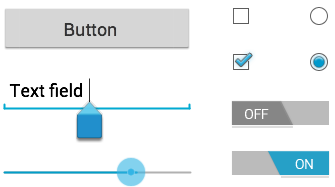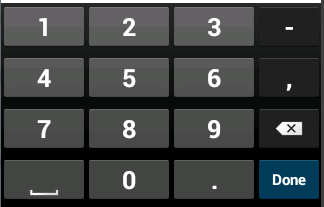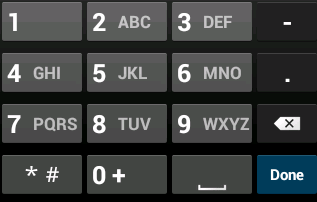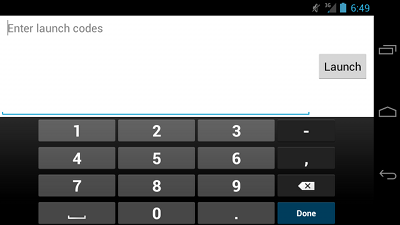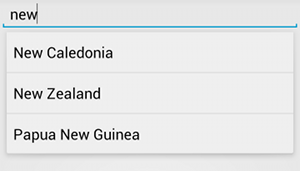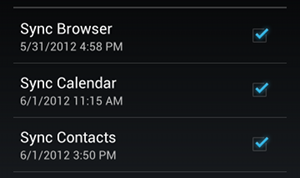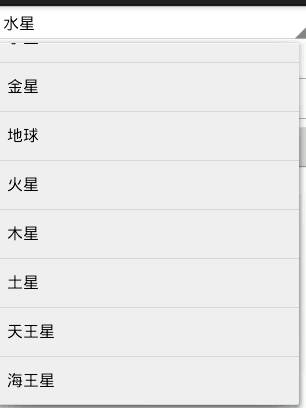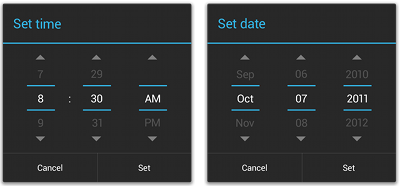[forwarding]Android 常用控件讲解
Android输入控件是一种用于人机交互的元件,Android为此提供了各种各样的输入控件,例如:按钮(Button),文本域(text fields),拖动条(seek bars),复选框(checkBos),缩放按钮(zoom buttons),开关按钮(togglebuttons),等等。
为UI添加输入控件,只需要在对应的布局文件(XML Layout)添加对应的控件节点。如下,是一个包含编辑框和按钮的布局文件:
|
1
2
3
4
5
6
7
8
9
10
11
12
13
14
15
16
|
<?xml version="1.0" encoding="utf-8"?><LinearLayout xmlns:android="http://schemas.android.com/apk/res/android" android:layout_width="fill_parent" android:layout_height="fill_parent" android:orientation="horizontal"> <EditText android:id="@+id/edit_message" android:layout_weight="1" android:layout_width="0dp" android:layout_height="wrap_content" android:hint="@string/edit_message" /> <Button android:id="@+id/button_send" android:layout_width="wrap_content" android:layout_height="wrap_content" android:text="@string/button_send" android:onClick="sendMessage" /></LinearLayout> |
每个输⼊控件都支持⼀个特定的输⼊事件,如当用户输⼊文本或触摸⼀个按钮,这样你就可以执行一个动作(处理事件)。
常规控制元件
下表列出了在App常用的输入元件,若要了解更为详细的信息,看参阅官方文档。
|
控件类型 |
描述 |
相关类 |
|
按钮,可以被用户按下或点击,以执行⼀个动作 |
||
|
可编辑的文本区域,可以使用 |
||
|
复选框,⼀个可以由用户切换的ON/OFF开关。当提供给用户⼀组不互斥的可选项时,你应该使用复选框 |
||
|
单选按钮,与CheckBox类型,只是一组里只能选择一个选项 |
||
|
切换按钮,带有亮度显示的 ON/OFF 按钮 |
||
|
下拉列表,让用户从一系列的值中选择一个值 |
||
|
选择器,一个通过使用向上/向下按钮或手势从⼀系列值中选择⼀个值的对话框。用DatePicker输⼊日期(月,日,年)或用TimePicker输⼊时间(⼩时,分钟,上午/下午),这将被自动的格式化为用户区域的值(本地化)。 |
tips: 除了以上输入控件,Android还有很多未列出来的控件,可以浏览android.widget包去了解更多的控件信息。如果您的应用程序需要特定的输⼊控件,你可以自定义该组件。
Buttons
在Android里,Button可以有一下三种显示(纯文本,图片,或者文本+图片)。
根据给出来的三种形式,你可以在布局文件中通过以下三种方法创建一个Button。
纯文本组成,使用Button节点
|
1
2
3
4
5
6
|
<Button android:layout_width="wrap_content" android:layout_height="wrap_content" android:text="@string/button_text" ... /> |
由图片组成,使用ImageButton 节点(需要把相应的图片添加到drawable文件夹里)
|
1
2
3
4
5
|
<ImageButton android:layout_width="wrap_content" android:layout_height="wrap_content" android:src="@drawable/button_icon" ... /> |
文本+图片,使用Button节点和android:drawableLeft属性
|
1
2
3
4
5
6
|
<Button android:layout_width="wrap_content" android:layout_height="wrap_content" android:text="@string/button_text" android:drawableLeft="@drawable/button_icon" ... /> |
tips:还有drawableRight,drawableTop,drawableBottom,drawablePadding等等
如何响应Button的点击事件
响应Button的点击事件,大概可以分为以下两种方式:
1、在java代码里添加事件监听器:
|
1
2
3
4
5
6
|
Button button = (Button) findViewById(R.id.button_send);button.setOnClickListener(new View.OnClickListener() { public void onClick(View v) { // 响应按钮点击事件 }}); |
2、在布局文件里定义Button的行为属性onClick,如下所示:
|
1
2
3
4
5
6
7
|
<?xml version="1.0" encoding="utf-8"?><Button xmlns:android="http://schemas.android.com/apk/res/android" android:id="@+id/button_send" android:layout_width="wrap_content" android:layout_height="wrap_content" android:text="@string/button_send" android:onClick="sendMessage" /> |
这样,在点击Button时,便会调用Activity里的sendMessage()方法处理事件。
在Activity里实现对应的事件处理方法sendMessage
|
1
2
3
4
|
/** 点击Button时调用*/publicvoid sendMessage(View view){ // 处理逻辑} |
使用这种xml的定义方式,有以下几点是需要注意的:
(1)在布局文件里onClick属性的值(onClick_event)必须与Activity里方法名(onClick_event)一致(在这指sendMessage的一致)
(2)方法onClick_event返回值必须为void,且为public方法
(3)onClick_event只能一个参数View,View指事件源(Button)
tips:在没有特别要求的情况下,可以选择其中一种来响应Button的点击事件。如果需要初始化Button控件或者在Fragment定义Button的响应方法,选择使用第一种方式。
定义Button的样式
不同版本的Android系统或者说由不同厂家生产的Android手机,其Button的默认显示样式都会有所不同。如果需要控制Button在各种版本显示一致的样式,可以选择定义App的主题样式。如:在Android4..0或者更高的版本中,可以定义Holo的主题样式——在manifest.xml的<application>节点添加属性(低版本的系统需要添加对应支持包)
android:theme="@android:style/Theme.Holo"
类似的,可以通过在布局文件里<Button>节点添加属性android:background来定义Button的背景,其背景可以是一张图片或者是某种特定额颜色。
android:background="@drawable/button_icon"
无框Button
偶尔,也许你会使用到无框按钮,可以通过在布局文件的<Button>节点添加borderlessButtonStyle来定义无框按钮
|
1
2
3
4
5
6
7
|
<Button android:id="@+id/button_send" android:layout_width="wrap_content" android:layout_height="wrap_content" android:text="@string/button_send" android:onClick="sendMessage" style="?android:attr/borderlessButtonStyle" /> |
自定义Button的背景
有时候为了炫酷的外观和用户体验的需要,需要重新定义Button的背景和形状(并不是简简单单地添加一张图片或者改变背景颜色)。那又是如何去美化Button默认的显示样式:
Demo1:使用位图来改变Button三种状态的样式(default—默认样式,pressed—被点击时样式,focused—获得焦点时的样式)
第一步:选好或者制作好Button各种状态下的背景图片。需要注意的是,制作的图片要适应不同大小的Button,可以选择制成nine-patch位图。
第二步:将做好的图片放到目录res/drawable/下,并为图片统一命名,如button_default.9.png,button_pressed.9.png,,button_focused.9.png.
第三步:在res/drawable/下创建xml文件(button_custom.xml),如下:
|
1
2
3
4
5
6
7
8
|
<?xml version="1.0" encoding="utf-8"?><selector xmlns:android="http://schemas.android.com/apk/res/android"> <item android:drawable="@drawable/button_pressed" android:state_pressed="true" /> <item android:drawable="@drawable/button_focused" android:state_focused="true" /> <item android:drawable="@drawable/button_default" /></selector> |
如此,便可为Button指定各种状态下的背景图片。
第四步:在布局文件里创建Button按钮,添加background属性(其值为@drawable/button_custom)
|
1
2
3
4
5
6
7
|
<Button android:id="@+id/button_send" android:layout_width="wrap_content" android:layout_height="wrap_content" android:text="@string/button_send" android:onClick="sendMessage" android:background="@drawable/button_custom" /> |
注意:在button_custom.xml文件里,<item>有着顺序之分的,android会自上往下去搜索第一个满足条件的<item>,搜到就停止往下搜索。所以默认的显示图片需要放在最后一个。
Text Fields
文本域组件中,EditText就是我们常用的一个组件。 EditText是一个非常重要的组件,可以说它是用户和App进行数据传输窗户,有了它就等于有了一扇和App传输的门,通过它用户可以把数据传给App,然后得到我们想要的数据。EditText是TextView的子类,所以TextView的方法和特性同样存在于EditText中,有兴趣的可以参阅官方文档了解TextView的特性。
为文本指定特定的软键盘类型
文本域里可以输入不同类型的信息,如数字、密码、email等等,在输入时,系统会根据输入类型来决定弹出哪一种虚拟键盘。那呀如何来确定文本域的输入类型呢??
在节点EditText里通过添加属性android:inputType来控制文本域的输入类型,如一个输入email的文本域,可以这样定义:
|
1
2
3
4
5
6
|
<EditText android:id="@+id/email_address" android:layout_width="fill_parent" android:layout_height="wrap_content" android:hint="@string/email_hint" android:inputType="textEmailAddress" /> |
对应弹出的键盘如下:
常用inputType有以下几种:
“text”:常规文本键盘
“textEmailAddress”:带有‘@’符号的常规文本键盘
“textUrl”:带有‘/’的常规文本键盘
“number”:数字键盘
“phone”:拨号键盘
数字键盘
常规文本键盘
定制键盘的其他表现形式
通过属性android:inputTyp同样可以定制特定的键盘行为,如使首字母大写,使用拼写建议等等。
属性android:inputType是通过按位组合得到值的,所以你可以一次性定制一个或多个值(使用“|”隔开)。
下面给出属性android:inputType常用的值:
"textCapSentences"常规文本键盘,句子首字母大写
"textCapWords" 常规文本键盘,所有单词首字母大写。(适合用来输入标题和人名)
"textAutoCorrect" 常规文本键盘,会纠正单词拼写错误
"textPassword" 数字键盘,以原点显示输入的数据
"textMultiLine" 常规文本键盘,允许用户输入多行文本
如下:定义了一个单词首字母大写,没有拼写建议的键盘
Demo:
|
1
2
3
4
5
6
|
<EditText android:id="@+id/postal_address" android:layout_width="fill_parent" android:layout_height="wrap_content" android:hint="@string/postal_address_hint" android:inputType="textCapWords|textNoSuggestions" /> |
定制键盘指定键的Action
除了可以控制键盘的输入类型,我们一样可以去定制指定键(“回车键”)的Action。例如让“回车键”具有“发送”或者“搜索”的功能。
可以通过属性android:imeOptions来设置此Action,如下,使“回车键”具有“发送”的功能。
|
1
2
3
4
5
6
7
|
<EditText android:id="@+id/search" android:layout_width="fill_parent" android:layout_height="wrap_content" android:hint="@string/search_hint" android:inputType="text" android:imeOptions="actionSend" /> |
附:如果没有显式指定属性android:imeOptions的值,系统会自动往后搜索是否有可以获得焦点的组件,如果存在这样的组件,此时的“回车键”会显示为“Next”(actionNext);如果没有则显示为“Done”(actionDone)。
监听“回车键”的Action
如果通过android:imeOptions定制了“回车键”的Action(例如上文的“actionSend”),你需要使用TextView.OnEditorActionListener监听它的Action。监听器TextView.OnEditorActionListener.里有一个回调方法onEditorAction(),当中参数actionId用来识别哪一种Action,如IME_ACTION_SEND和IME_ACTION_SEARCH.。
Demo:监听是否按下了“Send”(actionSend)按钮。
|
1
2
3
4
5
6
7
8
9
10
11
12
|
EditText editText = (EditText) findViewById(R.id.search);editText.setOnEditorActionListener(new OnEditorActionListener() { @Override public boolean onEditorAction(TextView v, int actionId, KeyEvent event) { boolean handled = false; if (actionId == EditorInfo.IME_ACTION_SEND) { sendMessage(); handled = true; } return handled; }}); |
如果屏幕够大(如横屏的时候),你可以在EditText旁自定义一个按钮(用来实现某种逻辑),通过属性android:imeActionLabel来设置
|
1
2
3
4
5
6
7
|
<EditText android:id="@+id/launch_codes" android:layout_width="fill_parent" android:layout_height="wrap_content" android:hint="@string/enter_launch_codes" android:inputType="number" android:imeActionLabel="@string/launch" /> |
创建带有提示文的文本域
使用EditText的子类AutoCompleteTextView,可以创建带有提示文的文本域。根据提示文的来源不同(数据库或数组),AutoCompleteTextView提供了不同的适配器。
如下,演示如何使用ArrayAdapter(数组适配器)来创建AutoCompleteTextView。
第一步:在布局文件里添加节点AutoCompleteTextView
|
1
2
3
4
|
<AutoCompleteTextView xmlns:android="http://schemas.android.com/apk/res/android" android:id="@+id/autocomplete_country" android:layout_width="fill_parent" android:layout_height="wrap_content" /> |
第二步:在strings.xml定义提示文数组,这里以输入国家名为列,给出各个国家名的提示:
|
1
2
3
4
5
6
7
8
9
10
11
12
13
14
15
16
|
<?xml version="1.0" encoding="utf-8"?><resources> <string-array name="countries_array"> <item>Afghanistan</item> <item>Albania</item> <item>Algeria</item> <item>American Samoa</item> <item>Andorra</item> <item>Angola</item> <item>Anguilla</item> <item>Antarctica</item> ... <item>China</item> ... </string-array></resources> |
第三步:在Activity或Fragment里为AutoCompleteTextView设置适配器:
|
1
2
3
4
5
6
7
|
// 获得AutoCompleteTextView组件AutoCompleteTextView textView = (AutoCompleteTextView) findViewById(R.id.autocomplete_country);// 从strings.xml获得国家名称的数组String[] countries = getResources().getStringArray(R.array.countries_array);// 创建适配器,并用setAdapter()为AutoCompleteTextView设置此适配器ArrayAdapter<String> adapter = new ArrayAdapter<String>(this, android.R.layout.simple_list_item_1, countries);textView.setAdapter(adapter); |
在这里,ArrayAdapter绑定了国家名称的数组countries,并以TextView的形式和simple_list_item_1的布局显示。布局simple_list_item_1是Android系统为列表信息的显示提供的一种标准外观。
效果如图:
附:在这里只是为演示功能的使用,所有并没有设置所有的国家名称提示文,(可根据App的实际需要来设置提示文)
Checkboxes(复选框)
CheckBos(复选框)的主要功能就是完成复选框额操作,在用户输入信息时,可以一次性选择多个内容。例如,用户在选择个人兴趣爱好时,或者用户在设置系统的功能时,这样选项一定会存在一个或多个,则此时可以直接使用CheckBox完成此功能。
监听CheckBox的点击事件
往布局文件里的<CheckBox>节点添加属性android:onClick,其值为调用的方法名(与上文Button用法类似)。
Demo:
在布局文件定义两个CheckBox
|
1
2
3
4
5
6
7
8
9
10
11
12
13
14
15
16
|
<?xml version="1.0" encoding="utf-8"?><LinearLayout xmlns:android="http://schemas.android.com/apk/res/android" android:orientation="vertical" android:layout_width="fill_parent" android:layout_height="fill_parent"> <CheckBox android:id="@+id/checkbox_meat" android:layout_width="wrap_content" android:layout_height="wrap_content" android:text="@string/meat" android:onClick="onCheckboxClicked"/> <CheckBox android:id="@+id/checkbox_cheese" android:layout_width="wrap_content" android:layout_height="wrap_content" android:text="@string/cheese" android:onClick="onCheckboxClicked"/></LinearLayout> |
在Activity里实现对应的事件处理方法:
|
1
2
3
4
5
6
7
8
9
10
11
12
13
14
15
16
17
18
19
20
|
public void onCheckboxClicked(View view) { // 获得checkBox的选中状态(选中或不选) boolean checked = ((CheckBox) view).isChecked(); switch(view.getId()) {//通过Id获得改变了状态的CheckBox case R.id.checkbox_meat: if (checked) // 选中状态下的逻辑 else // 没有选中状态下的逻辑 break; case R.id.checkbox_cheese: if (checked) //选中状态下的逻辑 else //没有选中状态下的逻辑 break; // ... }} |
使用这种xml设置响应方式的定义方式,有以下几点是需要注意的:
(1)在布局文件里onClick属性的值(onClick_event)必须与Activity里方法名(onClick_event)一致(在这指onCheckboxClicked的一致)
(2)方法onClick_event返回值必须为void,且为public方法
(3)onClick_event只能一个参数View,View指事件源(CheckBox)
同样地,可以在java代码里添加监听器(CompoundButton.OnCheckedChangeListener):
|
1
2
3
4
5
6
7
8
9
10
11
12
|
meat = (CheckBox) findViewById(R.id.checkbox_meat);// 给CheckBox设置事件监听meat.setOnCheckedChangeListener(new CompoundButton.OnCheckedChangeListener() { @Override public void onCheckedChanged(CompoundButton buttonView, boolean isChecked) { if (isChecked) { // 选中状态下的逻辑 } else { // 没有选中状态下的逻辑 } } }); |
tips:可以用setchecked(boolean)或 toggle()方法来设置checkbox的选中状态。
Radio Buttons
RadioButton(单选按钮)提供了一种多选一的操作模式(添加到RadioGroup里),例如从性别“男”或“女”中选择一个。
Demo:
在布局文件里定义RadioGroup和RadioButton,
|
1
2
3
4
5
6
7
8
9
10
11
12
13
14
15
16
|
<?xml version="1.0" encoding="utf-8"?><RadioGroup xmlns:android="http://schemas.android.com/apk/res/android" android:layout_width="fill_parent" android:layout_height="wrap_content" android:orientation="vertical"> <RadioButton android:id="@+id/radio_pirates" android:layout_width="wrap_content" android:layout_height="wrap_content" android:text="@string/pirates" android:onClick="onRadioButtonClicked"/> <RadioButton android:id="@+id/radio_ninjas" android:layout_width="wrap_content" android:layout_height="wrap_content" android:text="@string/ninjas" android:onClick="onRadioButtonClicked"/></RadioGroup> |
附:RadioGroup是LinearLayout的一个子类,其orientation默认为vertical。
在Activity里实现对应的事件处理方法:
|
1
2
3
4
5
6
7
8
9
10
11
12
13
14
15
|
public void onRadioButtonClicked(View view) { // 获得RadioButton的选中状态(选还是没选) boolean checked = ((RadioButton) view).isChecked(); switch(view.getId()) {//通过Id获得改变了状态的CheckBox case R.id.radio_pirates: if (checked) // 选中了R.id.radio_pirates break; case R.id.radio_ninjas: if (checked) // 选中了R.id.radio_ninjas break; }} |
使用这种xml设置响应方式的定义方式,有以下几点是需要注意的:
(1)在布局文件里onClick属性的值(onClick_event)必须与Activity里方法名(onClick_event)一致(在这指onRadioButtonClicked的一致)
(2)方法onClick_event返回值必须为void,且为public方法
(3)onClick_event只能一个参数View,View指事件源(RadioButton)
同样地,可以在java代码里添加监听器(RadioGroup.OnCheckedChangeListener,注意这里的监听器和上文提到的CompoundButton.OnCheckedChangeListener是不一样的),实现方法与上文类似,在此需要为RadioGroup添加一个Id(radioGroup)
|
1
2
3
4
5
6
7
8
9
10
11
12
13
14
15
|
// 通过findViewById获得RadioGroup对象 raGroup = (RadioGroup) findViewById(R.id.radioGroup); // 添加事件监听器 raGroup.setOnCheckedChangeListener(new RadioGroup.OnCheckedChangeListener() { @Override public void onCheckedChanged(RadioGroup group, int checkedId) { if (checkedId == R.id.radio_pirates) { // 选中R.id. radio_pirates的逻辑 } else if (checkedId == R.id.radio_ninjas) { // 选中R.id.radio_ninjas的逻辑 } else { // 其他逻辑 } } }); |
Toggle Buttons
ToggleButton(开关按钮)是让用户(对某功能)在on/off下选择,并可以不同的状态on/off设置不同的显示文本。在Android 4.0(API 14)之后,提供了另外一种表现形式Switches,如下所示:
ToggleButton 和 Switch 都是CompoundButton的子类,所以可以选择类似的方式来使用ToggleButton或 Switch。
设置ToggleButtons的响应方式
在布局文件<ToggleButton>或<Switch>节点添加属性android:onClick .
|
1
2
3
4
5
6
7
|
<ToggleButton android:id="@+id/togglebutton" android:layout_width="wrap_content" android:layout_height="wrap_content" android:textOn="on" android:textOff="off" android:onClick="onToggleClicked"/> |
附:属性textOn和textOff用来设置ToggleButton on/off状态下显示的文本,在Android4.0或更高的版本,可以使用<Switch>来代替<ToggleButton>
在Activity里实现对应的事件处理方法:
|
1
2
3
4
5
6
7
8
9
10
|
public void onToggleClicked (View view) { // 判断是否处在“on”状态下 boolean on = ((ToggleButton) view).isChecked(); if (on) { // on 状态下的逻辑 } else { // off 状态下的逻辑 }} |
使用这种xml设置响应方式的定义方式,有以下几点是需要注意的:
(1)在布局文件里onClick属性的值(onClick_event)必须与Activity里方法名(onClick_event)一致(在这指onToggleClicked的一致)
(2)方法onClick_event返回值必须为void,且为public方法
(3)onClick_event只能一个参数View,View指事件源(ToggleButton)
同样地,可以在java代码里添加监听器(CompoundButton.OnCheckedChangeListener),实现方法与上文类似
|
1
2
3
4
5
6
7
8
9
10
|
ToggleButton toggle = (ToggleButton) findViewById(R.id.togglebutton);toggle.setOnCheckedChangeListener(new CompoundButton.OnCheckedChangeListener() { public void onCheckedChanged(CompoundButton buttonView, boolean isChecked) { if (isChecked) { // on 状态下的逻辑 } else { // off状态下的逻辑 } }}); |
Spinners
Spinner(下拉列表),以列表的形式供用户去选择,与CheckBox(复选框)或RadioButton(单选按钮)相比,Spinner可以节省手机的屏幕空间。
Demo:
在布局文件里定义一个下拉列表:
|
1
2
3
4
|
<Spinner android:id="@+id/planets_spinner" android:layout_width="fill_parent" android:layout_height="wrap_content" /> |
在布局文件定义了<Spinner>节点之后,接着需要设置其显示的列表项,根据列表项数据来源的不同,可以创建不同的适配器(类似于AutoCompleteTextView的实现)。比较常用的有ArrayAdapter适配器,下面演示一下其用法(以八大恒星为例)
第一步:在strings.xml添加数组plantts_array
|
1
2
3
4
5
6
7
8
9
10
11
12
13
|
<?xml version="1.0" encoding="utf-8"?><resources> <string-arrayname="planets_array"> <item>水星</item> <item>金星</item> <item>地球</item> <item>火星</item> <item>木星</item> <item>土星</item> <item>天王星</item> <item>海王星</item> </string-array></resources> |
第二步:在Activity或 Fragment里设置Spinner的适配器:
|
1
2
3
4
5
6
7
|
Spinner spinner =(Spinner) findViewById(R.id.spinner);// 使用默认的下拉列表布局和数组plants_array来创建数组适配器ArrayAdapterArrayAdapter<CharSequence> adapter =ArrayAdapter.createFromResource(this,R.array.planets_array, android.R.layout.simple_spinner_item);// 指定所弹出的下拉列表的布局方式adapter.setDropDownViewResource(android.R.layout.simple_spinner_dropdown_item);// 为spinner设置适配器spinner.setAdapter(adapter); |
附:simple_spinner_item 和 simple_spinner_dropdown_item都是系统为下拉列表提供的一种布局方式。
有着另外一种更加简单配置方法,如下:
第一步与上面一样,在strings.xml添加数组planets_array。
第二步:在<Spinner>节点添加属性android:entries,其值指向planets_array数组
|
1
2
3
4
5
|
<Spinner android:id="@+id/planets_spinner" android:layout_width="fill_parent" android:layout_height="wrap_content" android:entries="@array/planets_array"/> |
其实现效果是一样的。
响应用户的选择
监听用户的选择,需要实现监听器AdapterView.OnItemSelectedListener内的方法onItemSelected()和onNothingSelected(),如下给出了实现此监听器的Activity。
|
1
2
3
4
5
6
7
8
9
10
|
public class SpinnerActivity extends Activity implements OnItemSelectedListener { ... public void onItemSelected(AdapterView<?> parent, View view, int pos, long id) { //可以使用方法parent.getItemAtPosition(pos)获得用户选择的选项 } public void onNothingSelected(AdapterView<?> parent) { //用户没有选取任何选项时触发此方法 }} |
接着通过setOnItemSelectedListener()为spinner设置监听器,代码如下:
|
1
2
|
Spinner spinner =(Spinner) findViewById(R.id.spinner);spinner.setOnItemSelectedListener(this); |
附:同样也可以使用内部类的方式为spinner设置监听器,实现方式与前文提到的组件类似。
Pickers(选择器)
android 为用户提供里一个选择时间/日期的现成对话框,如图。
Picker(选择器)自动调整为当地的语言环境,可以确保你得到一个遵循一定格式的时间(或者日期)。
推荐使用DialogFragment来管理时间和日期选择器,因为DialogFragment会为你管理这些选择器的生命周期,且允许在不同的布局配置里显示这些选择器(如在小屏幕的手机上显示为基本的对话框,在大屏幕上则内嵌如到布局里去)。
附:从Android3.0开始才开始支持DialogFragment,如果需要运行在低版本的手机上,可以添加对应的支持包。
创建时间选择器Time Picker
要使用DialogFragment来显示TimePickerDialog,需要做到以下三点:
1、创建一个片段类继承TimePickerFragment继承DialogFragment
2、在onCreateDialog()里返回TimePickerDialog的对象
3、实现TimePickerDialog.OnTimeSetListener接口
如下:
|
1
2
3
4
5
6
7
8
9
10
11
12
13
14
|
public static class TimePickerFragment extends DialogFragment implementsTimePickerDialog.OnTimeSetListener { @Override public Dialog onCreateDialog(Bundle savedInstanceState) { //用当前时间作为picker的默认时间 final Calendar c = Calendar.getInstance(); int hour = c.get(Calendar.HOUR_OF_DAY); int minute = c.get(Calendar.MINUTE); // 创建TimePickerDialog对象并返回该对象 return new TimePickerDialog(getActivity(), this, hour, minute,DateFormat.is24HourFormat(getActivity())); } public void onTimeSet(TimePicker view, int hourOfDay, int minute) { //当用户设置好(点击“Set”按钮)之后的逻辑 }} |
附:可参考API文档了解各个参数的意义
设计好TimePickerFragment之后,需要做的就是,在Activity创建TimePickerFragment的对象并调用其show()方法即可
如下:定义了一个按钮,点击后便后弹出TimePickerDialog
|
1
2
3
4
5
|
<Button android:layout_width="wrap_content" android:layout_height="wrap_content" android:text="@string/pick_time" android:onClick="showTimePickerDialog" /> |
Button对应的事件处理方法如下:
|
1
2
3
4
|
public void showTimePickerDialog(View v) { DialogFragment newFragment = new TimePickerFragment(); newFragment.show(getSupportFragmentManager(), "timePicker");} |
创建日期选择器(Date Picker)
其方法与时间选择器类似。
要使用DialogFragment来显示DatePickerDialog,需要做到以下三点:
1、创建一个片段类继承DatePickerFragment继承DialogFragment
2、在onCreateDialog()里返回DatePickerDialog的对象
3、实现DatePickerDialog.OnDateSetListener接口
代码如下:
|
1
2
3
4
5
6
7
8
9
10
11
12
13
14
15
|
public static class DatePickerFragment extends DialogFragment implementsDatePickerDialog.OnDateSetListener { @Override public Dialog onCreateDialog(Bundle savedInstanceState) { //使用当前日期作为date picker 的默认显示日期 final Calendar c = Calendar.getInstance(); int year = c.get(Calendar.YEAR); int month = c.get(Calendar.MONTH); int day = c.get(Calendar.DAY_OF_MONTH); // 创建 DatePickerDialog 对象并返回给对象 return new DatePickerDialog(getActivity(), this, year, month, day); } public void onDateSet(DatePicker view, int year, int month, int day) { //当用户设置好(点击“Set”按钮)之后的逻辑 }} |
接着定义一个Button
|
1
2
3
4
5
|
<Button android:layout_width="wrap_content" android:layout_height="wrap_content" android:text="@string/pick_date" android:onClick="showDatePickerDialog" /> |
最后在Activity里实现对应的事件处理方法
|
1
2
3
4
|
public void showDatePickerDialog(View v) { DialogFragment newFragment = new DatePickerFragment(); newFragment.show(getSupportFragmentManager(), "datePicker");} |
本文出自 “静心天涯” 博客,请务必保留此出处http://peiquan.blog.51cto.com/7518552/1283065


